Campaign History of the 151e Régiment d'Infanterie - IX
~ 1915 ~
In Champagne - (7 October - 31 December)
7-9 October: The regiment’s situation remains unchanged from 7-9 October -- they continue to occupy the same first-line trenches. Losses for the regiment on 7 October include 2 killed (Sdts. Picardin, Fichel) and 5 wounded (Sdts. Pinaud, Maillot, Marie (Maurice), Bihouée (Francois), Paret, (Francois), Paret, Sumoinot [sp?], Legrand (Georges)). During the night of 8 October, the 151 provides a working party to the engineers to establish a second line trench facing north. Additionally, four listening posts are pushed forward 15 meters from the first line trench. From 1900 to 2200 hrs there is a violent bombardment of the regiment’s trenches, particularly the southern trench. The remnants of 1 Bat. are reconstituted in the evening into two companies. Transfers:
Capt. Le Boulanger takes command of the 3 Bat.
Sous-Lieut. Castet-Baron takes command of the first group of three companies.
Sous-Lieut. Pesnoyers of the 4 Co. takes command of the second group of four companies.
Sous-Lieut. Ganot takes command of the 11 Co.
Losses for the regiment on 8 October include 1 killed (Sdt. Casearet) and 13 wounded (Sdts. Michau, Vasseur, Roche, Cozigou, Heuriet, Caudron, Delherue, Cherrier, Lobjoie, Groult, Marie (Maurice), Lobiau [sp?], Bihouée (Ferinin).
During the night of 9 October, the regiment again provides workers to the engineers to complete the construction of the second-line trench. Additionally, the listening posts in front of the first-line are pushed forward another 25 meters. The entire day of 10 October is spent cleaning and repairing the trenches. The regiment is relieved at night by the 16 BCP. Losses for the regiment on 8 October include 3 killed (Sdts. Thibert, Cuminal, Moutte) and 16 wounded (Sdts. Vandenboossche, Martin (Philippe), Le Gall (Yves), Bordat (Leon), Voledier, Leborgne, Allard, Mené, Barben, Ellary, Colloir [sp?], Mariot, Quibliez, Rotiez, Lanes (Remy), Varlet).
11-18 October: On 11 October, the 151 is finally taken off the line and returns to Mourmelon-le-Grand (12 km behind the lines) where it billets in the barracks where it will remain until 18 October. Transfers:
Lieut.-Colonel Moisson, his head still bandaged in gauze, retakes command of the regiment after being wounded on 6 October.
Capt. Le Boulanger officially takes command of 1 Bat. (Cmdt. Le Monig commanding it since 7 Oct.)
Commandant Berger takes command of 3 Bat.
Sous-Lieut. Langlois d’Estaintot coming from the maréchaux de logis of the 27e Dragoons (reserve TT) is assigned to the 10 Co.
Sous-Lieut. Dreyssaire [Dresseyre] comes from the adjudants of the 2e Escadron du Train (CVAX territorial TT) is assigned to the 12 Co.
A detachment of reinforcements composed of 418 troops arrive from the divisional battalion reserve. NOTE: No mention is made as to whether these men are either wholly or even partly incorporated into the ranks. Given the additional reinforcements to arrive (presumably on request) to the regiment in the weeks to come, any incorporation must have likely been partial.
The regiment is at rest on 12 October and the men spend the day cleaning themselves and their uniforms and equipment. Transfers:
Médecin Aide-Major Galan returns to the 46 RAC and M.A.M. Rivière is assigned to 2 Bat
Sous-Lieut. de la Ferrière (previously wounded, evacuated) returns and take command of 9 Co.
Sous-Lieut. Campana (previously evacuated) takes command of 1 Co. (Note: Campana had returned originally on 4 Oct.).
For his part, the former Saint-Cyr cadet Sous-Lieut. Campana, was not impressed with the replacements who had been sent to reform the 1 Co. The company was now composed of 220 men transferred from the depots of Northern regiments. Campana decided the best course was to be draconian in his handling of the new men, punishing severely the most minor infraction. Overtime he would ease up but only after he had brought what he saw as unruly soldiers to heel. When one of his corporals failed to report for company roll -- the man was apparently drunk -- he broke his rank and replaced him with an exemplary soldier from 5 Co. he'd fought with in the Argonne.
Campana's patience would be strained further by a 28 year old soldier from Courrières who Campana referred to as a "true anarchist". In Campana's memoir he goes by the name of Derbar. Coming back from exercises one day, Campana explained to his men what had transpired in the attack of 6 October but did his best to reassure to not be discouraged.
"Don't lose confidence because we've faced a check. War is not made up entirely of victories, hope is needed..."Campana had also put two young NCOs under arrest for failing to get control of their sections in the proper time. Angered by his overzealous discipline, Campana got word that the two were threatening to give him a bullet once they got to the trenches. Undeterred, Campana decided to take on the mutinous talk head-on. Assembling his company the next morning:
"All we can hope for in the 151st is to get punched in the face!"It was Derbar who mouthed off and was showing off in front of his comrades. I had him immediately conducted to prison for eight days, and letting him know that his next infraction would mean an appearance before a war council.
"I know that some among you have declared that I was a filthy cow and that upon arriving in the trenches, they would lay me low. Well we'll be there shortly, I'll wait with a smile on my face this famous bullet that will assassinate me. We'll see if the braggarts who are here now will be as swift in their actions as they are in their words."On 13 October, the regiment begins to reorganized and spends the day exercises. Situation remains the same until 18 October. Transfers for 13-16 Oct:I looked several of them in the eyes and see them turn pale and lower their heads. I feel perfectly as ease about their threats, they're really just kids.
Sous-Lieut. Leymaire coming from Engineers Co. 6/3 is assigned first 1 Co. then to 9 Co.
Sous-Lieut. Nugon of 5 Co. takes command of 2 Co.
Sous-Lieut. de la Ferrière who’d been given command of 9 Co. is instead given command of 1 Co.
Sous-Lieut. Le Gallo retakes command of 9 Co.
Lieut. Ternisien coming from 12 RIT is assigned to 8 Co.
Sous-Lieut. Baillat coming from 12 RIT is assigned to 5 Co.
Lieut. Boissin coming from the depot of 8e [RI?] takes command of 2 Co.
Capt. Carrère coming from 234 RI takes command of 1 Co.
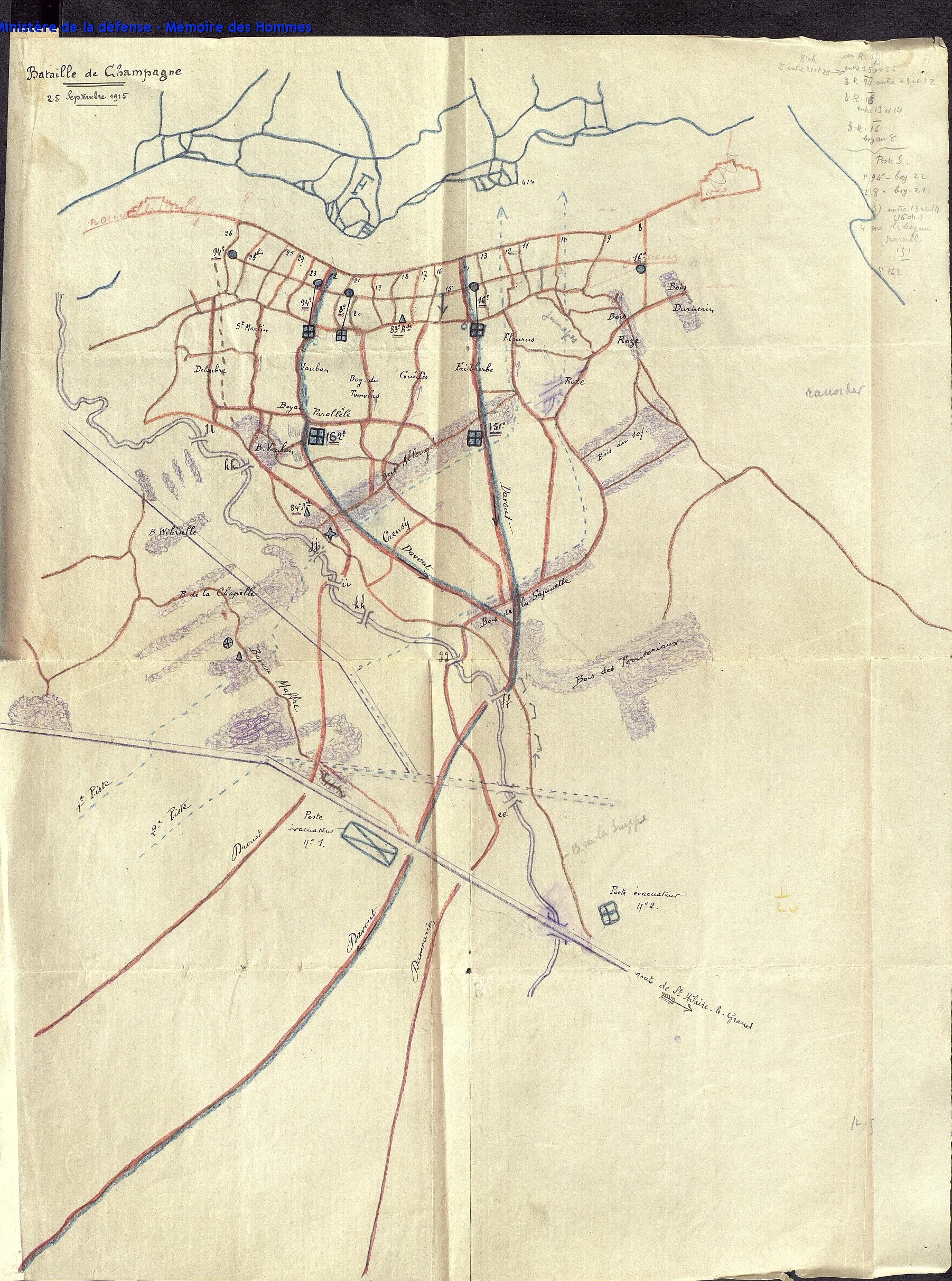
Map from the 42 DI Medical Services JMO showing the regimental first-aid and evacuation posts, along with the various trenches and boyaux the 151e RI would occupy in October and November 1915.
19-31 October: The regiment goes back up to the trenches. At 0900 hrs, General Deville (commanding 42 DI) awards the Croix de la Légion d’Honneur to Monsieur Médecin Major Idrac before the officers of the 151 RI and 7 Co. which is in arms in front of the barracks of the Fleurus Quarter. The regiment departs at noon, the battalions leaving in half hour intervals. The 151 goes to occupy the left sub-sector from boyau 16 to boyau 26, in liaison to the right with the 162 RI and to the left with the 315 RI. The 1 and 2 Bats. take up the first-line with 3 Bat. in reserve and a company in the parallel trench, one in the parallel boyau and two others in the Bois Vauban. The 2 Bat. to right has two companies in the first-line and two in support, the 1 Bat. to the left with three companies in the first line and one in support. The relief is completed at 1700 hrs under heavy fire by the German artillery but suffer few casualties.
One of those who was with the regiment was Cpl. Henri Laporte. Having survived days of heavy in the Argonne, Laporte came down with typhoid and was evacuated in July 1915. After months of recovery, Laporte volunteered to leave the depot at Quimper and rejoin the 151 at the front, arriving in mid-October. Laporte was again assigned to the 8 Co., but apart from his lieutenant and a few survivors, he found no other comrades remaining from his old company. The regiment had been entirely reformed following the massacres in the preceding weeks. Going back up to the trenches on 15 October, Laporte was struck by the difference between the Argonne sector and Champagne. The vast mournful plains of chalky Champagne contrasted greatly with the ravined claustrophobia of the wooded Bois de la Gruerie.
What a strange character these battlefields of Champagne! A wet, chalky, white and gray ground. A little vegetation at the camp entrance -- some tuffs of meager saplings -- and after that the great sad and desolate plain, like an immense cemetery for the living. After marching an hour over open ground, we advanced in single file columns and began to head into the communication trenches filled with water and white mud, sticky and freezing. It rained with stop (as the snow melted) since our departure. In certain spots we were forced to get down and put our knees down into the mud in order to pass through log-covered passages where, in daylight, the enemy could see us.The men were covered in the white porridge-like mud from head to toe. For shelter, Laporte's half-section shared two underground gourbis (about 2 meters deep), with ten men per dugout.After three long hours of marching through these lines, we at last arrived at our trenches, but what a pitifully dirty state they were in...It was my first winter that I'd spend in the trenches...The rain doesn't stop falling. We occupied the first-line trenches. The Germans are about 100 meters from us. Aside from raids, it was no longer a war of bombs and grenades. It was the cannon that was the great master now.
We had to draw out the water which filled the bottom of our shelters to a depth of 50 cm (20 in). The water oozed out of each of the chalk walls. For the job, we used a canvas bucket and formed a chain. We then threw the water behind the parapets. After a half and hour of this work, we were wrapped up in our blankets soaking wet and with our heads resting against the walls (fortunately our helmets protected us a little from the damp). We tried to get some shut-eye but the cold prevented it. Incidentally, the water, which seeped into our clothing, soon forced us to start bailing water again. Some shells, exploding then and now, bringing us back to reality. The first night was pretty calm. At dawn, to stretch our legs we went and paid a visit to the comrades in the neighboring sections. The cold became more and more brisk.Once in its positions, the regiment is instructed to organize the sector defensively, including transforming the former parallel de départ into a first-line fire-trench, the work beginning at nightfall. Barbed-wire entanglements and Brun entanglements are erected in front of the regiment’s trenches. The German first line lies about 200 meters distant. Losses for the regiment on 19 October include 2 killed (Sdts. Michel (Eugenie), Emerie) and 1 wounded (Sdt. Oreve (Mathurin)). A detachment of reinforcements arrives from the 151 RI depot comprised of 140 troops, consisting of:
Aspirant Raymond Jubert
Sgt-Mjr Hespel
3 sergents
1 cap.-fourrier
9 caporaux
125 soldiers
The following transfers were made: Sous-Lieut. Basteau (previously wounded) returns and is assigned to 7 Co., and Sous-Lieut. de Moudion takes command of 11 Co.
On 20 October the German artillery bombards the regiment’s positions with all calibers of shells causing much material damage, which are then repaired during the night. Work also continues at night on the barbed-wire entanglements with the balance of workers being provided by 3 Bat. Losses for the regiment on 20 October include 4 wounded (Sgt. Arnoult; Sdts. Pluquet, Vauchet, Viol). The next day there is no change. Work continues on the barbed-wire entanglements. Losses for the regiment on 21 October include 10 wounded (Sdts. Thierry (Alfred), Duval (Fancois), Louerat, Delauoue ([sp?], Chrétion, Porée, Maugras, Moyse, Larpent, Brault).
The following transfers were made:
Lieut. Antonetti (previously wounded) returns and is assigned temporarily to CHR
Sous-Lieut. Baillat takes command of 5 Co., replacing Sous-Lieut. Mèche (evacuated).
Sous-Lieut. Le Gallo is promoted to lieutenant. Adj. Albertini, Adj. Dudou [sp?], and Asp. Dumesnil are promoted sous-lieutenants.
It is during this inactive spell in the trenches that Sous-Lieut. Campana records two anecdotes of interest. The first is humorous in nature and involves a certain fastidious staff major. Campana remarked that this officer had apparently mistaken the trenches for the camp barracks they had just come from, and the major made it his personal mission to see to it that the first line trenches were kept spic and span. Campana's first reaction was to joke with the major that they had been sent up to the trenches with rifles and not brooms. The major was note amused and proceeded to lecture Campana that his top task as an officer should be the creation of proper latrines. The major went so far as to suggest a design of his own creation, wherein a meter-deep pit would be dug behind the parados and between two traverses, and thereby afford both privacy and protection from enemy fire. The staff officer became so persistent on the topic that when the latrines were dug, the men took to calling them "staff listening posts." And while the latrines might have achieved the degree of privacy the major intended, the safety provided by the commodes was less convincing.
Several hours ago we received a volley of "toadies" [mortar shells], one of which fell in my trench and had only just exploded when I suddenly saw bolting from the regulation latrine Soldat Vermeulen, holding in one hand his breeches halfway up around his knees while his shirt remained pulled up in the most indecent fashion, exposing his naked belly. He was splattered from head to toe with a mix of excrement and earth, but mostly excrement, and trembled with fear in the middle of general hilarity:
--"Ah! Mon lieutenant," he stammered, "it wasn’t quite my time yet, for sure. This damn toady came straight down at me, I barely had time to relieve myself when it fell right in the middle of the latrine I was leaving! Fortunately for me it had made a fougasse, otherwise it would have vaporized me! A real geyser of shit! I was pressed up behind the first barricade of sandbags, thinking I was sheltered, but all the merchandise came down on my head and back, and there was a lot since the pit was almost full.
-- "That’s a system of drainage the major hadn’t foreseen. But...don’t come over here because you really stink!"
-- "Maybe put on our gas-masks?" one his laughing comrades proposed.
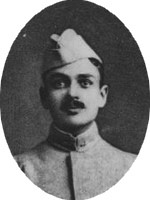
Sous-Lieut. Louis Henri Chedal-Bornu (KIA 25 September 1915).
The next anecdote Campana recorded was as somber as it was macabre. It had been fully a month since the bloody check the regiment had received on 25 September, in which entire companies had been mowed down in front of the intact belt of German barbed-wire. Since that terrible day (and the similar ill-starred 6 October), the long rows French dead lay stretched out on the ground before the regiment's original jumping-off positions. Campana had already attempted on one occasion to recover the body of his fellow Saint-Cyr comrade, Sous-Lieut. Louis Chedal-Bornu, who had fallen in the attack and not seen since. His first attempt proved unsuccessful, having only come up the remains of soldiers from the 94 RI, their bodies entirely torn to shreds by enemy machine-gun fire.
.jpg?dl=0)
Capt. Ernest Theodore Carrère (KIA 16 April 1917).
Upon learning of his sojourn, Capitaine Carrère forbid Campana from venturing out again. But the thought of his friend, along with countless others, suffering such an ignominious end was more than he could stand. Campana made an emotional appeal to his Captitaine Carrère:
"...[T]heir parents, ignorant of their true fate, would consider them as missing, a position which can lead these families down into the worst difficulties for interminable years. And this torture that created incertitude, this agonizing question posed every day when thinking of the loved-one: 'Is he alive? Is he dead?'"The Capt. Carrère was moved by Campana words and gave him permission to make another attempt to recover his friend's remains. Campana gathered up four stretcher-bearers on the night of 21 October, instructing them to bring back as many bodies as possible. The stretcher-bearers however did not share the same enthusiasm as Campana. The prospect of having to first cover such a distance over open ground covered with corpses and to work right under the noses of the Germans difficult and dangerous work, and not worth risking one's life over. Campana had instructed the men to start off at 2100 hrs but after an hour and a half had passed with no activity, Campana discovered the men sleeping in their trench. He was livid, and their response that they could not find surplus tent-canvases to carry the bodies in only infuriated the young lieutenant more. Threatening that he would relieve them of the stretcher-bearer duties and return them to the ranks, the four unhappy men immediately set off on their task. After what seemed an interminable journey, the party came across the first set of bodies about thirty in number. Most of them were lying face down, in the "prone" position they had likely taken in hopes of escaping the enemy gunfire.
Others though faced to the sky, knees pulled up into their chests, arms crossed, hands clutching tuffs of grass, indicating by their appearance how painful their suffering had been. The enemy was not far off, we could hear his picks at work in his trench. We took the cadaver that was closest to us. He was a big clean-shaven boy, his face was as black as soot. We lifted him up with difficulty. It was as though the ground was a like a jealous lover, desperately clinging on to keep him. Hardly had we lifted him up than a horrible odor overtook us. We wanted to hasten the dismal chore, and placed in the canvas another cadaver, but the rifle that his hand still grasped struck the barbed-wire. A shot rang out but no one was hit. Yet the alarm was given and bullets started whistling past. We ran back to our trench, dragging the two cadavers behind us.Once the shooting died down, Campana snipped the chains of the ID tags from the wrists of the dead around him with a pair of wire-cutters and then returned back to his trench. Not wanting to risk the lives of the living for the dead, Capt. Carrère forbade any more forays out into No-Man’s-Land. Campana remained satisfied that at least four dead comrades would receive marked graves, and the fate of another fifteen who had been "missing" for a month would be known.The next evening we recommenced our work, bringing back two more bodies without any difficulty. Suddenly, on our second trip out, we were met with an unexpected burst of gunfire. The stretcher-bearer to my right fell on top of me, though he was only wounded. We threw ourselves to the ground in all haste. The fusillade lasted more than an hour and for more than hour we had to lie among the dead. The putrid exhalations demoralized us more than the gun shots. Pressed up against me was a corpse, his face brushing up against mine. His mouth was wide open. I could not pull my eyes away from his half-closed eyes, which seemed to be mocking me. I dared not make a movement. I’ve never forgotten this sight. And at each moment, bullets drove into poor bodies already so torn up with a dull thud.
On 22 October, the day remains calm. No movement in the units. At night, work continues on erecting barbed-wire entanglements and laying out Brun entanglements. The next day, work on the trenches and wire is finally completed. Losses for the regiment on 23 October include 2 killed (Sdts. Horbin, Dodou) and 2 wounded (Sgt. Prébet, Sdt. Brechet). The following transfers were made: Sous-Lieut. Mèche and Sous-Lieut. Guilbaud are promoted to lieutenants.
On 24 October, 1 Co. which was in support relieves 4 Co. in the first-line, the latter moving into reserve. During the night, the defensive entanglements is reinforced with metal chevaux de frise 4 meters in length. Transporting these chevaux de frise proves very difficult owing to their size and weight, each taking 10 men to carry. Twenty of these had to be put in place on this night. Losses for the regiment on 24 October include 5 wounded (Sdts. Sauger, Vitse, Bruno, Rerseaven [sp?], Hendrick (Charles)).
On 25 October, the German artillery is less active but their infantry becomes more aggressive, firing more and particularly targeting the regiment’s loop-holes. Losses for the regiment on 25 October include 5 wounded (Sdts. Bord, Pascarel, Dhaussy, Chirengelli, Moraud (Hippolyte)). The following transfers were made: Sous-Lieut. Cavalier [alt. Cavailher] (previously wounded) returns and is assigned to 4 Co., Sous-Lieut. Depoilly (previously wounded) also returns and is assigned to 3 Co.
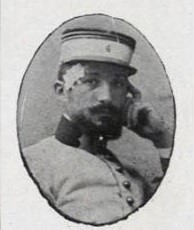
Sous-Lieut. Gustave Cavalier/Cavailher.
The following day the German artillery bombards the first-lines with all calibers of shells, causing significant material damage. During the night, the wire-entanglements are reinforced. The trenches, including the access boyaux, are redug. By this night, seventy-five metal chevaux de frise have been placed. Losses for the regiment on 26 October include 2 wounded (Sdts. Coroller, Biard). On 27 October, two companies of 3 Bat. in the Bois Vauban move up to replace the two companies in the trenches and parallel boyaux, the latter passing into reserve in Bois Vauban. Starting at 0900 hrs, two battalions of the 94 RI arrive to relieve in the two battalions (1 and 2 Bats.) of the 151 RI in the first line. The 3 Bat. remains in reserve of the sub-sector, while the 1 and 2 Bats. go to rest in the barracks at Mourmelon-le-Grand. Losses for the regiment on 27 October include 2 wounded (Sdts. Cheval, Husson).
At 0900 hrs on 28 October, 2 Bat. is reassembled in the camp to the east of the Châlons Road for awards. The regimental colors are taken by 8 Co. for the rewarding of the Croix de Guerre by General Deville (commanding 42 DI) and General Berthelot (commanding 32 CA) per Orders of the Division. General Berthelot passes in review of the troops then awards the Croix de la Légion d'Honneur to three officers and several Croix de Guerres, per Orders of the Army and the Corps d'Armée. The 2 Bat. then defiles before the generals and return to their barracks. Honors are rendered to the regimental colors. In the afternoon, 1 and 2 Bats. are employed in various chores and cleaning. The 3 Bat. continues to occupy its same positions in reserve of the sub-sector. Sous-Lieut. Chirelli [sp?] is evacuated for illness.
On 29 October, the battalions are at rest in the camp barracks and participate in exercises. Sdt. Gille (Hyppolyte) is wounded. The following day 1 Bat. leaves the camp barracks to relieve 3 Bat. in the left sub-sector reserve positions and 3 Bat. heads back to rest in the barracks. The 2 Bat. spends the day in exercises. Cpl. Bournisien is wounded. The following transfers are made: Lieut. Antonetti is transferred to 162 RI to take command of one of its battalions. Sous-Lieut. Dusmenil and Sous-Lieut. Cavalier of 4 Co. are assigned to [9 Co.?].
At 0900 hrs on 31 October General Berthelot and General Deville award the Croix de Guerre before the 151 RI and the reassembled 162 RI and their respective colors. Transfers: Sous-Lieut. Leymarie of 9 Co. is transferred to Engineers 6/3. A detachment of reinforcements of 72 troops coming from the 151 depot arrives comprised of:
1 aspirant
1 sergent-major
1 sergent
1 caporal-fourrier
3 caporaux
65 soldiers
1-16 November: At 0900 hrs there a service is held at the military cemetery at Mormelon to commemorate the dead of the 42 DI. One picket company of the 151 RI, the regimental colors and band, and detachments from each company assist in carrying out the ceremony. In the afternoon, the 2 and 3 Bats. which are in camp perform exercises; 1 Bat. remains in reserve of the left sub-sector. Médecin Auxiliare Colson is promoted to Médecin Aide-Major de 2e classe and is assigned to the CHR. There is no change on 2 or 3 November. On 4 November, the 2 and 3 Bats. leave camp to relieve two battalions of 94 RI in the first-line of the left sub-sector. The 2 Bat. is on the right from boyau 16 up to boyau 22, with two companies in the first-line and two in support. The 3 Bat. is on the left from boyau 22 to boyau 26, with three companies in the first-line and one in support. Lieut.-colonel Moisson takes command of PC4. Losses for the regiment on 4 November include 1 killed (Sdt. Randeneau [sp?]) and 1 wounded (Cpl. Parmentier).
During the afternoon of 5 November, the Germans send over minnens (heavy mortars). Orders arrive for the 151: for the eight-day period that the regiment occupies the trenches, the regiment is to complete the wire-entanglements in front of the first-line. This belt must be at least 12 meters thick. Additionally, it must completely transform the first-line and second line by changing it from a continuous line to a series of ouvrages de section ("platoon fortresses") joined by a support trench. These works are to be provide flank support to each other.
On 6 November, there is incoming fire from 77s and 105s, particularly on western side of the sector. During the day but primarily at night, the regiment works actively to reorganize the sector. The 1 Bat., in reserve, provides work parties to the units in the first-line. Sous-Lieut. Campana records this in his own memoir, stating:
I've received orders to have a connecting trench dug. I dread these nocturnal chore. I would prefer to attack rather than remain from 8 pm to 4 am pestering the men and demanding of them a task that sleep and exhaustion sometimes rendered very difficult...the men prefer to be in the first line than the third...especially when we're copiously showered with projectiles...Losses for the regiment on 6 November include 1 wounded (Sdt. Dumoret). The following transfers are made: Capt. Le Boulanger retakes command of 11 Co. Commandant Marc Arthur Oblet arrives from the interior and takes command of 1 Bat. Work continues the next day. Owing to the likelihood of a German poison gas attack, a gas drill is performed by each company, and the results prove very satisfactory. On 7 November there are 4 wounded (Cpl. Gauthier (Alphonse); Sdts. Thomas (Claude), Chavarin (Maxime), Massé (Guillaume)).
On the night of 8 November, the JMO notes that the Germans interrupt the regiment's work on the wire-entanglements through an incessant small-arms fire. Meanwhile Sous-Lieut. Campana was commanding two companies of 1 Bat, which had been digging a connecting trench for the last three nights. Around 2200 hrs, German 77 shells began coming down in their rear. The mean near Campana continued working but when he went off to check on the progress of others further away, he found the men lying in the bottom of the trench.
I climbed up on the parapet and scolded them:The work continues unabated for a while before German mortar shells start to drop sporadically along the line. When one of the 'minen' lands and explodes 5 meters from the parapet, Campana could make out the screams of a man over the noise of the explosion:
"I'm walking around out in the open and you, who are protected by two embankments of earth, you're hiding like rabbits at the bottom of their holes. Alright, get up! And try to use your tools with more energy!"They immediately retake their task. I walked for a long while still from one point of the trench to the other, and always on the parapet to give them confidence...In one section though I saw a soldier still lying down. I called over a nearby corporal:
"Corporal, hand out a punishment to this man.
"I can't, mon Lieutenant.
"How's that?
"No, I can't, it's Sergent Nanthouard." "Sergent Nanthouard! A sergent lying down as his men work! Oh, what a fine example! Get up! Get up now! Piss off back to your dugout, I don't want to see you in front of me anymore, I want to smash break this stick over your back! Tomorrow I'm filing a report to the Commandant to break your rank!"
"Save me! Save me! I'm a dead man!"(Campana's impression of his men and their conduct would over the next two months greatly improve, after a long period of building back the corps d'éspirit.) On 8 November there's 1 wounded (Sdt. Comble (Paul)). The next day and night work resumes and is actively carried out. A detachment of reinforcements composed of 147 troops arrives from the 151 depot consisting of:And this was the start of the stampede. Helmets, rifles, tools, equipment all abandoned, the men scatter like a band of minnows. And though there were brave men among them, the contagion had spread. Sometimes all it took was one coward to arouse panic in a whole company. Revolver in hand, I reassembled them in the boyau. My NCOs were of great help to me.
"You have no shame! Frenchmen running away like rabbits! Chickens! Cowards! And these are the soldiers of the 151e RI who stopped the Kaiser on the Yser and the Crown Prince in the Argonne! This can't be. If I reported your conduct to the Colonel he'd strip the Croix de Guerre from the fanions of your two companies. You're going to return to the trench immediately, recollect your helmets, your tools, your rifles. Reassemble here in a quarter hour. We're staying here under bombardment until all the shovels, picks and weapons are all found. Go!"
They didn't have to be told twice. The minen were falling more numerous, the fire getting closer. The men returned and I passed them in review, which was easy enough to do as the moon was rising, then we went back to the billets.
Lieut. Guillot
Adjs. Bertin-Boussu and Van den Ostende
6 sergents
10 caporaux
128 soldiers On 9 November there is 1 killed (Sdt. Bezard (Albert)) and 1 wounded (Sdt. Rouxel (Joseph)).
The sector remains calm on 10 November. The regiment carries out another poison gas drill again with excellent results. On 10 November there are 7 wounded (Sgt. Wiolaud (Georges); Sdt. Vidille (Jean), Citeau (Julien), Rolland (Jean), de Bomard (Pierre), Tambom (Jules), Dehollander (Adolphe)). The 11 November is a calm day. The work is once again carried out with vigor. The entire front of the sector has been set up with a thick belt of wire-entanglements. On 11 November there is 1 wounded (Cap. Passerieux (Adrien)). The following transfers are made: Capt. Savary returns (previously evacuated) and takes back up his functions as capitaine-adjoint. Sous-Lieut. Dumesnil transfers from the 4 Co. to 9 Co. Lieut. Guillot takes command of 4 Co.
The regiment is relieved on 12 November by the 94 RI. Lieut.-Colonel Moisson is relieved at PC4 by Lieut.-Colonel Saintenac (94 RI). The entire regiment is at rest in the barracks at Mourmelon. The men will spend the next day working to cleaning and exercising. The following transfers are made: Lieut. Laurent takes command of 10 Co. replacing Capt. Destrais who is evacuated. The 14-16 November will be spent in the same way. Technically the men were "at rest."
Our rest ends tomorrow, but how can we call this 'rest' when we go off on exercises every day from 0800 hrs to 1000 hrs and from 1300 hrs to 1600 hrs?...When our men come out of the trenches they need to forget they’re at war for awhile...to banish the obsessive vision of death which so haunts them. So why are we on maneuvers morning and evening? Arms drill, platoon exercises, bayonet fencing – are these still any use in the war we’re waging now? In my view, the exercises serve only to annoy the men; but orders are orders and we have to follow them.On 16 November, Lieut. Liethoudt arrives from the 151 depot to take command of 5 Co. The detachment of reinforcements is comprised of 72 troops, consisting of:
Lieut. de Ville Chabrolle
Sous-Lieut. Poussiere (assigned to 9 Co.)
2 sergents
4 caporaux
63 soldiers
Aspirant Raymond Jubert is brevetted to Sous-Lieut. in the 11 Co.
17-30 November: Lieut.-Colonel Moisson awards the Croix de Guerre to certain soldiers of the 151 RI and 162 RI. The 3 Bat. and two machine-gun companies take part in the review. The regimental colors are taken by 9 Co. After the award ceremony, the troops defile before General Deville (commanding 42 DI) and return to their billets. The regiment remains in billets for two days more. On 19 November Lieut.-Colonel Moisson introduces Commandant Oblet to his battalion (1 Bat.), which is assembled under arms on the front boundary of the camp. Sous-Lieut. Baillat is evacuated due to illness.
On 20 November, the regiment, having departed camp at 0500 hrs, relieves the 94 RI in the left sub-sector beginning at 0900 hrs. The relieving companies stagger themselves out to arrive every half hour, with the relief ending at 1400 hrs. The arrangement of the companies is as follows: 1 Bat. in the first-line on the right, with 1 Co. to the right and 4 Co. in support, and 3 Co. on the left with 2 Co. in support. The 3 Bat. was on the left, with 9 Co. to the right and 10 Co. in support, and 12 Co. on the left with 11 Co. in support. The 2 Bat. was in reserve with 6 and 8 cos. Between l’Avenue Vauban and Tumulus, and 5 and 7 Cos. at the Bois Vauban. During this spell in the trenches the regiment is put to work finishing the arrangement of the new works, including firing-steps, underground galleries to serve as shelters for the men. Sous-Lieut. Campana described one of the shelters, the digging of which was facilitated by the chalky soil:
I've had a large cellar dug into the chalk which can hold my entire section [~50 men]. It's accessed by two stair cases, each 15-steps, which descend from the trench 20 meters from each other. There's nothing to worry about in such a shelter. We're protected from the shells by a layer of 6 meters of earth.My soldiers worked with much ardor as they understood the usefulness of their task. I've grouped them two by two and therefore constituted work comrades, similar to the combat comrades of the old regulations. I've given them the freedom to group themselves as they please, since I noted that Pierre works better with Jean than with Paul. Our "sap" was done in 4 days.
The inside [of the shelter] retains a very nice heat which contrasts with the cold of the outside air. With the help of logs and beams, I've had baggage planks made on which the men place their haversacks and their bread. Some old bayonets stuck in the ceiling hold candles and serve as lighting when the night comes. For a shelter in the first-line, it's more than comfortable. I've decided that having a second "sap" made for my own personal use is absolutely unnecessary. I set myself up with my soldiers and a tent-canvas separated me from them so I'm not disturbed.
The day is calm on 21 November. Some 77s fall primarily on the 1 Bat. positions. The companies work on organizing the lines, with 2 Bat. providing working parties to the first-line. The regiment is put through another gas drill in anticipation of the eventuality of a gas attack. It takes around five minutes for all troops to get their masks and goggles on (likely the P2 compress and Meyrowitz goggles. Losses for the regiment on 21 November include 1 killed (Sdt. Sirjacques (Julien)) and 2 wounded (Sdts. Giranet (Léon), Clahaut. Sous-Lieut. Moudion is evacuated. Capt. Tison takes command of 5 Co.
Work continues into the next day as well. Lieut. Lament (10 Co.) is evacuated. Sous-Lieut. Seillier and a group of sergents from the 46 RIC are assigned to 2 Co. On 23 November, German artillery fire several salvoes of 77s on ouvrage B18. Sous-Lieut. de la Ferrière of 1 Co. transfers to 10 Co. to take command. Sous-Lieut. Ottavi and Eckeus arrive to the regiment and are assigned to the 1 and 12 Cos. respectively. Edmond Mesté comes from the Maréchal des Logis of the CMTR BI No. 1 [Compagnie de Mitrailleuses de Brigade d'Infanterie No. 1] is promoted to sous-lieutenant and is assigned to the CMTR BI. On 23 November there are 2 wounded (Adj. Bertin-Boussu (Pierre); Sdt. Guiot (Alphonse). Sous-Lieut Dumesnil (9 Co.) is evacuated, along with MAM Minkowski (3 Bat.).
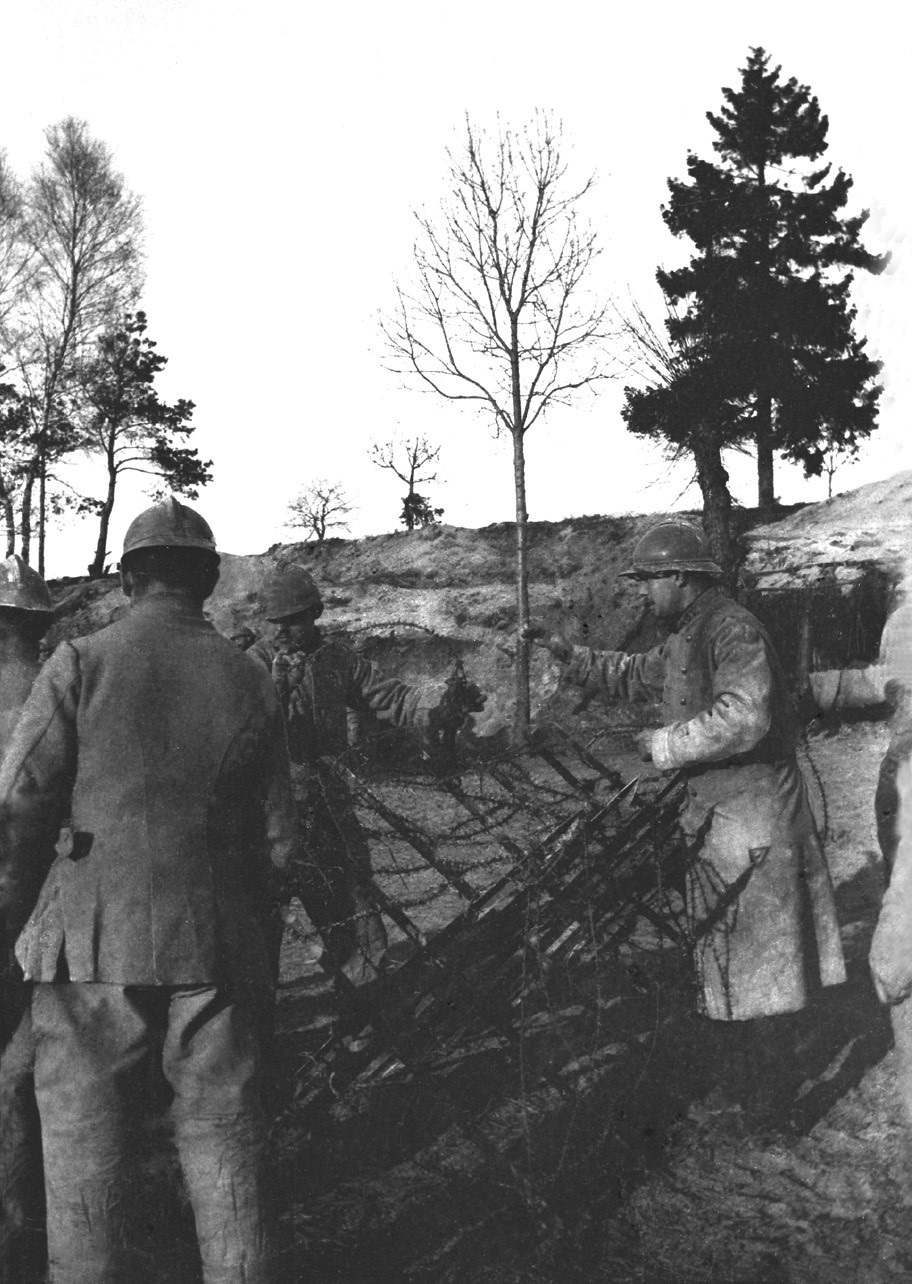
Men of the 151 constructing chevaux de frise - November 1915. Photo taken by Capt. Tison, 151 RI).
On 24 November, the Germans heavily bombard the entire sector at 1100 hrs and 1400 hrs. At night, working parties from 2 Bat. (in support) are sent up to erect more entanglements (barbed-wire and chevaux de fries) in front of the ouvrage 1 bis. On 24 November there is 1 wounded (Sdt. Joanin (Camille)). Nothing much is noted in the JMO for the next few days aside from some salvoes of 77s hitting l'Avenue Vauban and Tumulus. Work continues on the lines on 25 and 26 November. On 26 November there are 2 wounded (Cap. Gauthier (Albert); Sdt. Vanneron (Auguste)). Sous-Lieut. Savary (brevetted) coming from the sergents-majors of the 114 RIT, is assigned to 9 Co.
Below these banal and briefly mentioned goings-on there were the many human dramas that went undocumented in the official records. We are fortunate to have Sous-Lieut. Campana's account of these days in the trenches of Champagne. On 26 November, the young Saint-Cyrien found himself in an advanced listening post only 60 meters from the German line.
The evening before last [24 November], the Boches left their trench in order to set up barbed-wire. I was able to clearly make out their silhouette. My men wanted to open fire I stopped them as there was a better way to handle it: I reported to the Captain's PC [Poste de Commandement] and telephoned the artillery. A few minutes later a rain of 75s came down on the German workers. It must have caused a lot of damage, for we heard moaning of many wounded all night long. My soldiers were having a great time. They had stood up all along the firing-steps so they didn't lose a moment of the show and they applauded like big kids. Little distractions of this kind are very good for boosting morale.Later, Campana goes into how he had organized his section for look-out and work duties. In his usual eccentric way, the sous-lieutenant also described how he ensured his sentinels remained vigilant during long night shifts.
Night and day three look-outs stand watch in the first-line and three more in the listening post, for I had divided my section into two teams. One team of look-outs who watch for two hours then rest for two hours, and one team of workers who work for two hours then rest for four hours. This division of work bears fruit.I go out at night to make my rounds and check on my sentinels. Each time I find them at their post and very alert. On the first night though, Bosc, a young man from the class of '15, had fallen asleep standing upright. I fired a shot of my revolver close to his ear. He let out a shout and tumbled down off the fire-step into the trench. He got back up trembling with fear:
"Alright, Bosc, what do say about the wake-up? Do you know that a sentinel who sleeps during his watch can be executed? Is that how you protect your comrades? And the revolver shot I fired to frighten you, a Boche could have been the one to shoot and kill you! Don't you understand that to fall asleep at your post, you're in a way giving yourself a death sentence? You want to get your throat cut by the first German patrol that comes by?
"I was so tired, mon yeuntnant [deformation of lieutenant]. I was standing up, but I swear it won't happen again.
"I won't punish you this time, but if you do it again, it's the war counsel for you!"
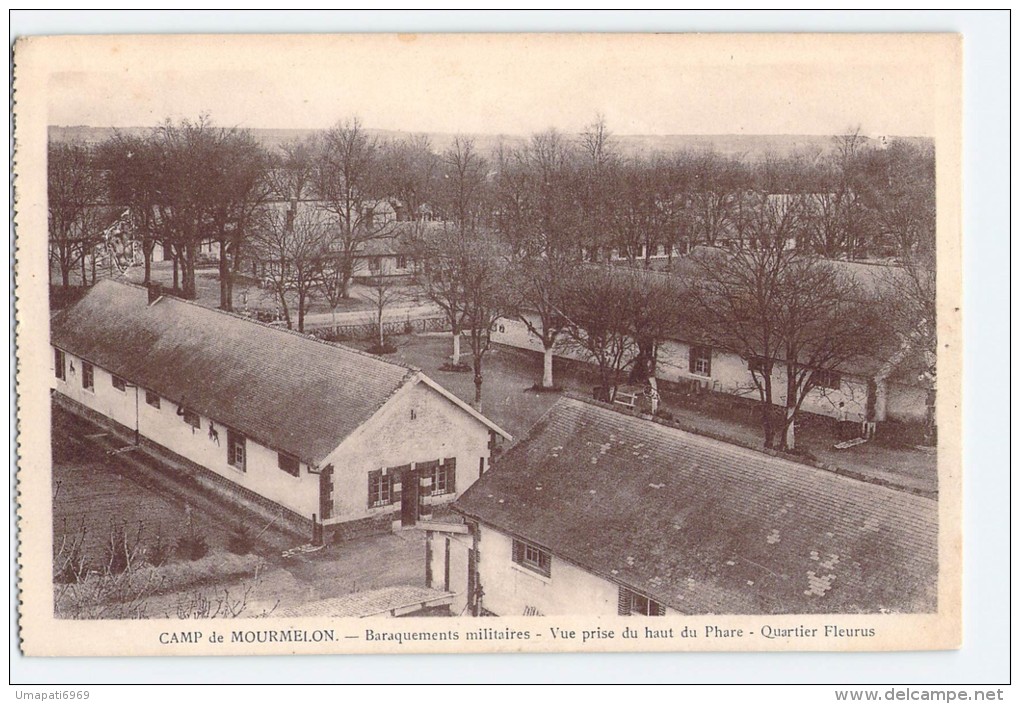

Fleurus Quarter at Camp Mourmelon.
Starting at 0900 hrs 27 November, the regiments is relieved in the left sub-sector by 8 BCP. The relief is completed by 1530 hrs. Commandant Lemoine (8 BCP) takes command of PC4. The 151 RI goes to rest at the barracks at Fleurus Quarter (Camp Mourmelon). On 28 November the men spend the day cleaning themselves and their gear at the barracks. Sous-Lieut. Hugau of 2 Co. is transferred to the CHR. The next day the regiment is takes up a schedule or exercises and work duties. A detachment of reinforcements arrives from the 151 RI depot comprised of 66 troops, consisting of:
1 aspirant
10 sergents
5 caporaux
50 soldiers
On 30 November, exercises and work continue. Another detachment of reinforcements arrives from the 151 RI depot comprised of 34 troops, consisting of:
3 sergents
4 caporaux
27 soldiers (all machine-gunners)
1-10 December: By December the Champagne front had truly become a quiet sector, defined by periodic shelling and occasional bursts of gunfire but, overall, a calm sector indeed. The 151 will continue with its schedule of exercises and work duties until 5 December. Other items of note: Commandant Oblet assumes command of the regiment as Lieut.-Colonel Moisson goes on leave. Sous-Lieut. de la Ferrière transfers from 10 Co. to 1 Co. Lieut. Laurent (previously evacuated) retakes command of 10 Co.
On 5 December, 2 Bat. is charged with repairing boyau Drouot, which had collapsed in certain places because of the rain. Sous-Lieut. de Lille de Loture (brevetted) coming from the Maréchal des Logis du PA of 6 CA is assigned to 10 Co. The 2 Bat. continues its work on boyau Drouot into the next day. The 1 Bat. provides 80 workers from each of its companies to the Mitry cavalry group to carry out leveling work for the second position between Baconnes and Aubérive. In addition, 1 Bat. will provide workers to the ENT work site. Sous-Lieut. Lamothe de Mondion (previously evacuated) returns and is transferred from 11 Co. to 12 Co. to take command in the absence of Lieut. Ternisien (evacuated). On 6 and 7 December, 3 Bat. provides workers to continue the repair work on boyau Drouot.
On 9 December the regiment relieves the 94 RI in Sector B (right and left sub-sectors). The companies go up to the line on the half-hours beginning at 0600 hrs. The placement of the battalions is as follows: on the right, 2 Bat. occupying from Ouvrage B1 to Ouvrage B3 bis and in liaison with 40 DI; on the left, 1 Bat. from Ouvrage B3 bis (excluded) to Ouvrage B10 (included) and in liaison with 60 DI; in reserve, 3 Bat. with 1 company in Bois Vauban, 1 company in the shelters of Boyau Creusy, 1 company at Bois Sapinette, and 1 company at Bois des Territoriaux. The relief is complete at 1400 hrs. With Lieut.-Colonel Moisson still on leave, Commandant Oblet takes command of PC4. Cap. Henri Laporte described what is was like to be in the trenches of Champagne in the winter:
We began again the "cavalcade" of passing through the communication trenches half filled with water and mud. Ice and snow made their appearance on the second day in the trenches. Our section had guard duty. Despite the intense cold, enormous rats ran through our trenches. We amuse ourselves by going after them with our bayonets, in order to keep warm. The food given to us was good but quickly turned cold as the kitchens weren't very close to the trenches and the ration party men accomplished a real feat each day to resupply us.On 10 December, 3 Bat. once again provides working parties to the two battalions in the first line. The men are tasked with cleaning and fixing the boyaux. The rains and daily wear-and-tear have transformed the boyaux into rivers 30-40 cm (12-15") deep in spots. The German artillery is also active all throughout the sector, firing 77s and 105s. Another gas drill is performed to test the mens' readiness, with satisfactory results. Sous-Lieut. Mollet (brevetted) arrives from the Major des Logis Chefs of the 40th Artillery (4 DI de Cavalry) is assigned to 8 Co.A glacial wind blew all night. I'd received from my mother a wool mountain-pass. It was welcome and retained the heat under my helmet. But it was the feet that really suffered. And in the morning after the second night spent in the line, as I was seated for a little while along the trench, I felt my stiff trousers partially frozen. So I made some efforts to try standing. I managed to do this, not without difficulty, and walked a hundred paces to keep the ice from freezing my feet, which had happened to one of my comrades that had been evacuated for this reason. You mustn't fall asleep: otherwise you'd suffer frost-bite, or even death.
11-31 December: On 11 December wiring parties are sent out to erect more barbed-wire entanglements in front of Ouvrage B3 bis, B4, and B4 bis. The next day there is some shelling by German 77s and rifle grenades on Ouvrage B10. The men work actively on the ouvrages of the old right sub-sector (constructing firing-steps, wattle revetments, etc.). Losses for the regiment on 12 December include 2 wounded (Sdts. Guellec (Francois), Monfort (Guillaume). On 13 December, salvoes of German 77s shell primarily the Avenue Vauban. Work continues on the positions. A detachment of reinforcements arrives from the 151 RI depot comprised of 112 troops, consisting of:
13 sergents
2 cap.-fourriers
13 caporaux
84 soldiers
On 14 December, the following transfers are noted: Sous-Lieut. de la Ferrière transfers from 1 Co. to 10 Co. Sous-Lieut. de Lille de Lotine [sp?] transfers from 10 Co. to 2 Co. The following day the regiment is partially relieved. The 1 Bat/151RI (on the right) is relieved by 2 Bat/162 RI and moves back to shelter in the shelters on St. Hilaire Road. The 1 Bat. is to rest six days and provide workers to the trenches at night for 2 Bat/162 RI. The 3 Bat/151 RI (in reserve) moves up to the first line on the left, relieving 1 Bat/151 RI which itself passes into reserve. Lieut.-Colonel Moisson is relieved at PC4 by Lieut-Colonel Claudon of the 162 RI and returns to Fleurus Quarter at Mourmelon, along with the CHR (telephonists, pioneers, health service). Final dispositions: sub-sector B on the left, 3 Bat.; in reserve, 1 Bat. with one company at Bois Vauban, one company in Boyau Creusy, one company at Bois Sapinette, and one company at Bois Territoriaux; 2 Bat. (the working unit) in the shelters of Saint Hilaire Road.
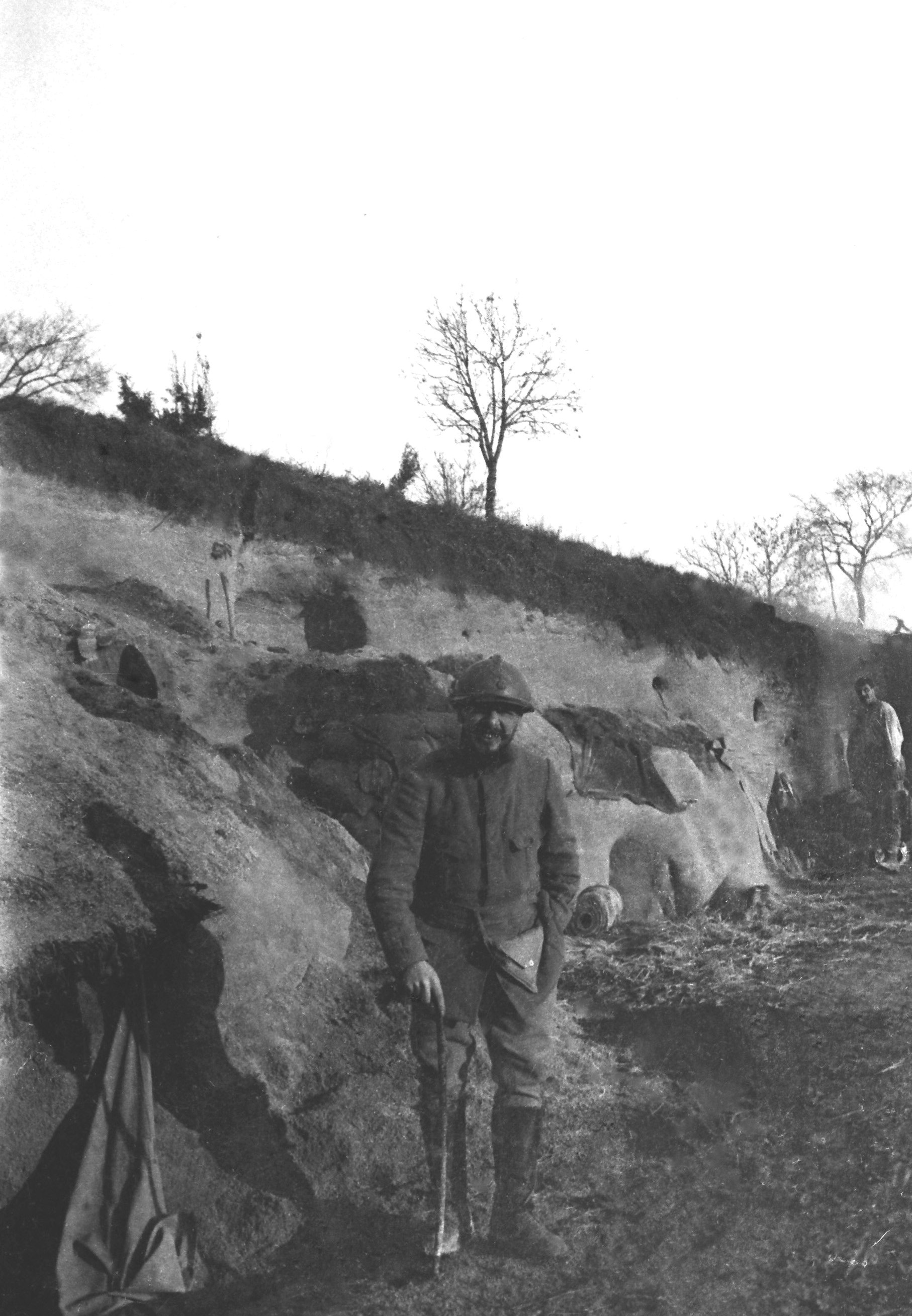
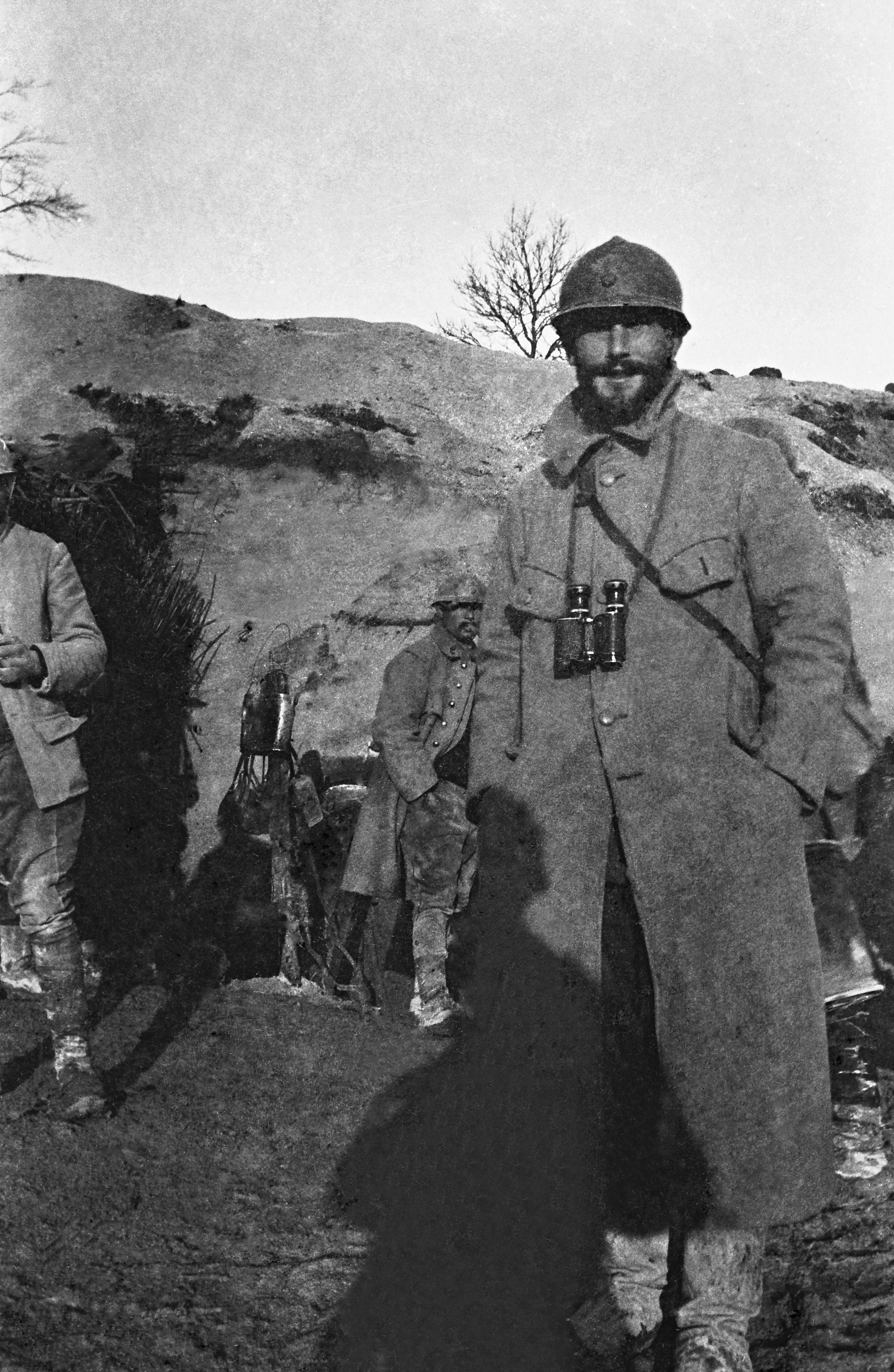
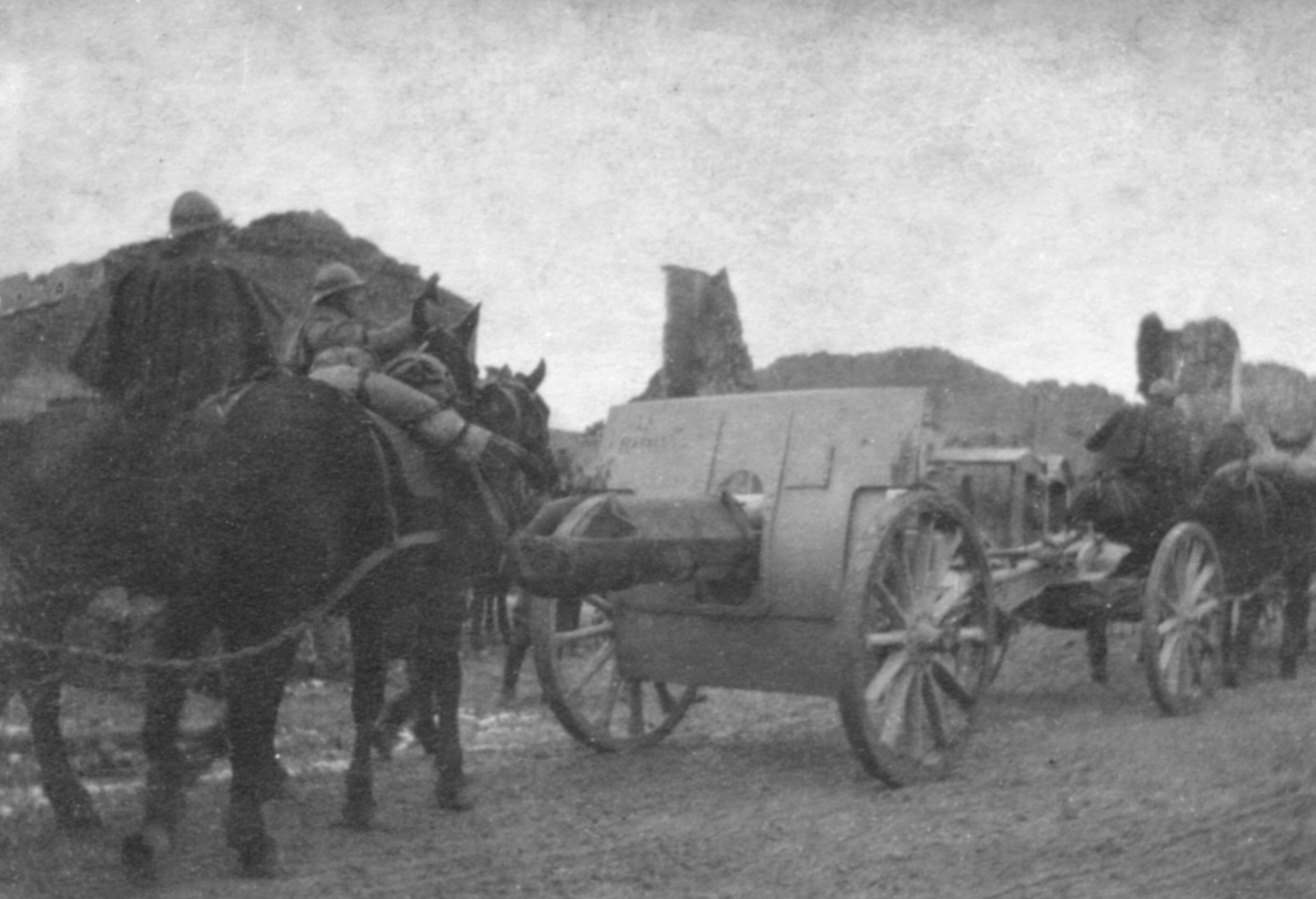
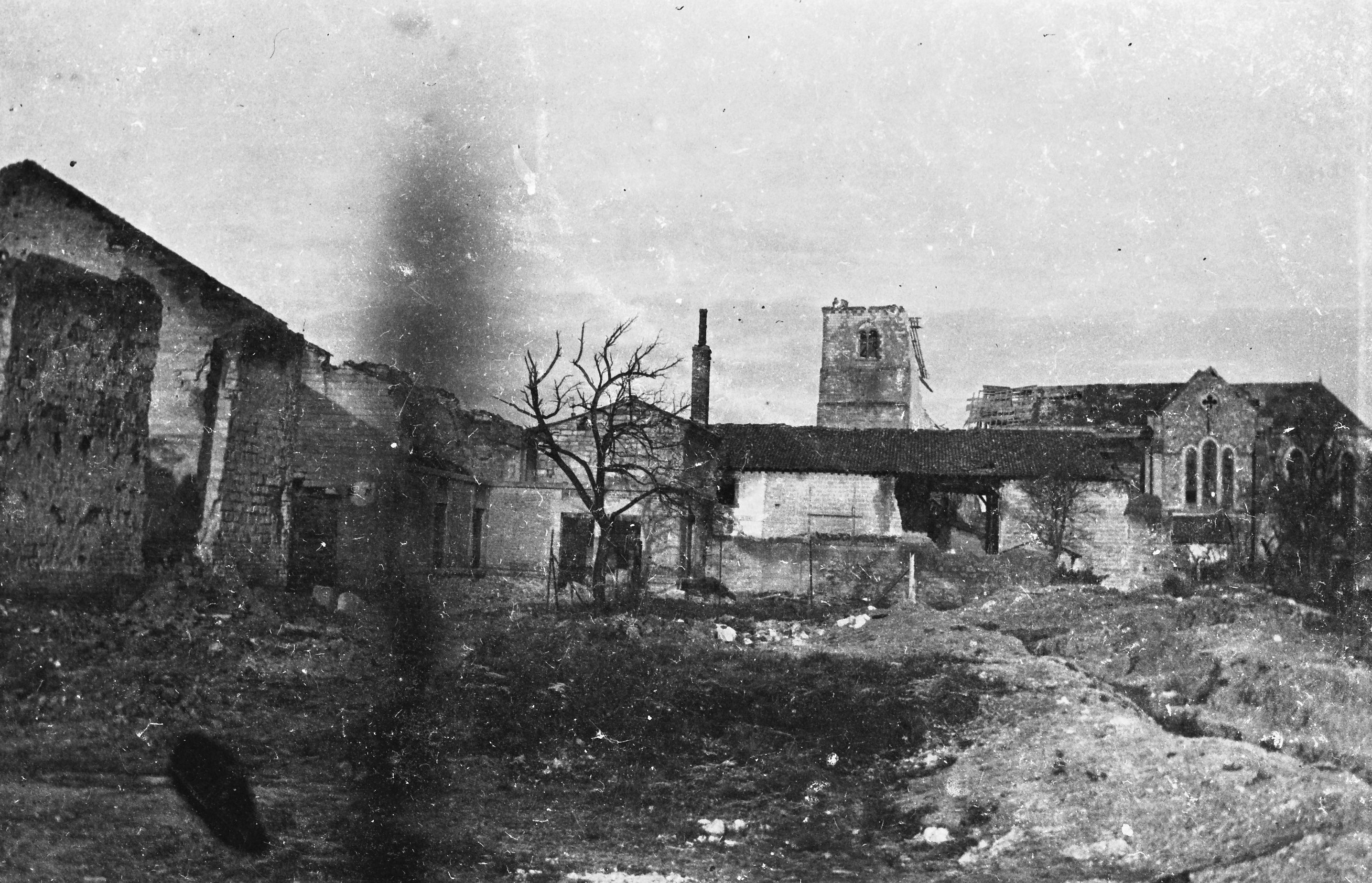

Officers (rank unknown) Liethondt and Guibault, likely at the shelters on Saint Hilaire Rd. - 19 December 1915; 105 gun; ruins of Saint Hilaire. Photos taken by Capt. Tison, 151 RI).
From 16-20 December, there is no change in the battalion's emplacements and nothing of note is recorded in the JMO. On 20 December, Lieut. Bourgoin arrives from the 151 RI depot and is detached to the Engineers Co. 6/53. A detachment of reinforcements also arrives from the 151 RI depot comprised of 58 troops, consisting of:
1 aspirant
1 sergent-fourrier
8 sergents
2 caporaux-fourriers
5 caporaux
41 soldiers
On 21 December, after 12 days of trenches, the regiment is relieved in sector B at 0800 hrs in the following manner: 3 Bat/151 RI is relieved by four companies of 8 BCP; 1 Bat/151 RI is relieved by two companies of 8 BCP and two companies of 16 BCP; 2 Bat/151 RI (the working unit) is relieved by 1 Bat/162 RI. Following the relief, 1 Bat. billets in the Fleurus Quarter barracks, 2 Bat. at Camp Deville (where Lieut.-Colonel Moisson established his PC), and 3 Bat. in the shelters of Left Ambulance. Capt. Coltat arrives from the 151 RI depot and temporarily takes over command of 3 Bat. from Capt. Le Boulanger, who himself retakes command of 11 Co. The regiment spends the next day cleaning up and installing itself in its rest areas.
On 23 December, 1 and 3 Bats. are ordered to provide workers to the Mitry cavalry group in order to again carry out leveling work for the second position between Baconnes and Aubérive. Transfers: Capt. Jelly (brevetted) of 2e Hussards takes command of the CMTR BI No. 1 [Compagnie de Mitrailleuses de Brigade d'Infanterie No. 1]. Sous-Lieut Mattei (brevetted) arrives from the Maréchaux des Logis of the cyclist group 6e DC and is assigned to 7 Co. Sous-Lieut. Baillat returns after being evacuated for illness and is assigned to 5 Co.
On 24 December, the three battalions are put through exercises according to the program arranged by Lieut-Colonel Moisson. the 1 Bat., which was quartered at Left Ambulance, moves to Camp Deville. Transfers: Commandant Tisseraud coming from the 151 RI depot takes command of 3 Bat., relieving Capt. Colta who takes command of 9 Co. The next day, Capt. Ritter, coming from CMTR BI, takes command of 3 Co.
On Christmas Day, the entire regiment is at rest. Sous-Lieutenant Campana of 1 Co. went out of his way to make the day special for his men. Knowing that many of them were from enemy occupied territories in the north and were cut off from their families, Campana with the help of some friends had arranged for a Marraine de Guerre to be assigned to each of his men. The Marraines didn't disappoint as they had sent nice letters and gifts to the men to arrive in time for the holiday.
The regiment spends the next five days in exercises. On 28 December, Lieut. Olivier arrives from the depot and takes command of 12 Co., replacing Sous-Lieut. de Moudion.
On 31 December, Lieut.-Colonel Moisson passes in review of the regiment at Camp Berthelot and awards Croix de Guerre, the regimental colors being carried by 9 Co. Moisson addresses his well wishes to the regiment as it evolves into a new army of specialists. Indeed, since the arrival of the replacements to fill the decimated ranks of 1 Co. in October, Sous-Lieut. Campana had seen great progress in the discipline and martial spirit of his men. The culmination of this metamorphosis was the New Year’s Eve review.
The 31st December the Colonel passed the regiment in review. This was superb. The battalions formed up in the great sunny fields. Far away, on the Moronvillers heights we saw rising up in big black or gray plumes the smoke of the 210 and 150 shells. The flag was the center of the festival, our old colors testify to the so many heroic fights and its glorious silk ravaged by the bullets flapped in the wind with pride. It’s to save this sacred thing, the emblem, the country, that so many brave men will sleep forever in the fields of Pierrepoint and the Marne, in the plains of Ypres, in the black woods of the Argonne and on the white soil of flea-ridden Champagne. It’s to save this still that these thousands of men are ready to sacrifice themselves in their turn in the battles to come.The parade was very beautiful. The magnificent regiment! The magnificent look! The magnificent soldiers! When you think of all these men fighting for months and months, when you think that they’ve held up to all the fatigues, all the sufferings that human will can endure, you say while watching them march with heads high, the martial allure: with such men we must and will conquer. And when some time from now set off to boot the enemy out of France, we’ll be proud to march at the head of such brave men and lead them to path of glory. In this prise d’armes I’ve found my dear 151st again. It will accomplish marvelous things soon.
The year 1915 proved itself to be a brutal ordeal for the 151e RI, as it had been for the French army on a whole. The names of the places and towns where the unit served became etched into the memory of those who experienced the greatest of hardships: Blanleuil, Fontaine aux Charmes, La Harazée, and Auberive-sur-Suippe. Innocuous monikers assumed great meaning and painful significance: Lost-Children, Dry Ravine, the Pig-Tail, the Goose-Foot, and Small Fort '414'.
In total, the 151e JMO reported almost 5,000 casualties in the year 1915, or a 154% loss. This number does not include the scores of men evacuated from illness, disease, frost bite, trench foot, or shell-shock.

Total number of casualties reported in the 151e RI JMO since August 1914. This figure represents losses reported chronologically and may include soldiers or officers wounded more than once over the course of the 15 months. This number does not include those evacuated for illness, disease, or shell-shock. Of note: almost half of the reported casualties occurred in the first five months of service.





